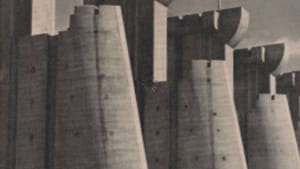Stay in the Loop
BSR publishes on a weekly schedule, with an email newsletter every Wednesday and Thursday morning. There’s no paywall, and subscribing is always free.
American vision
Princeton University Art Museum presents ‘Life Magazine and the Power of Photography’

Every Friday from 1936 to 1972, Life magazine brought the world to mailboxes and newsstands, introducing readers to people, places, and things they’d never seen and influencing their perceptions. From a time when newspapers and radio were the only other mass media and well into the television age, Life was the most popular magazine in America; at its height it reached a quarter of the US population. In a virtual exhibition, Life Magazine and the Power of Photography, Princeton University Art Museum considers the publication’s impact.
In 1951, Life followed a midwife into the back country of South Carolina to observe as she delivered an infant; 14 years later, it published images of a fetus in a womb. Life photographers put readers on the bloody beaches of Normandy and stood them on the surface of the moon. The magazine took Americans to a street market in 1948 China, and in 1964 it chronicled the magic of the Beatles. Life revealed the whole of human experience, the horror of genocide, the cruelty of racism, the universality of compassion, and the persistence of hope.
New views
Organized by Princeton Art Museum and the Museum of Fine Arts, Boston, the exhibition—originally physical, for now virtual—demonstrates how much skill and how many decisions it took to transform ideas into memorable stories. Large and small choices, many of them invisible, by photographers, writers, art directors, editors, and others, radically changed the look, feel, and effect of pieces, from the photojournalists chosen, to the content of “shooting scripts,” to picture selection, cropping, and placement.
“Life’s stories promoted a predominantly white, middle-class perspective on politics and culture,” gallery text tells us, acknowledging the orientation of founder Henry R. Luce and the magazine's reader demographics.
That said, Life didn’t hesitate to use staff and contributors representing other points of view, including renowned names in photojournalism. In the magazine's early years, it made Margaret Bourke-White the sole woman on its original staff of only four photographers, and it was her soaring image of Montana’s Fort Peck Dam that became Life’s first cover. This exhibition features several of Bourke-White’s images, including her revelatory 1943 portrait series of women working in the wartime steel industry.
In 1949 Gordon Parks became the magazine’s first Black staff photographer and writer on the strength of a photo essay he’d proposed and shot the previous year, Harlem Gang Leader. In it, Parks pierced the stereotype to show unexpected aspects of Red Jackson’s life by taking time to gain the 17-year-old’s trust. Parks, who became a filmmaker and documentarian, spent two decades at Life chronicling poverty, racism, fashion, and entertainment.

Pushing boundaries, opening eyes
Preparing to photograph a midwife at work, W. Eugene Smith took a two-week course in the specialty and chose Maude Callen as his subject. He spent a month shadowing her on calls in rural South Carolina, trudging through forests and up hillsides, making 2,600 images in all. In the process, the story expanded from a simple day-in-the-life essay into a visual indictment of regional poverty, inequities in living standards, and towering demands placed on midwives, most of them Black, who were the only medical help available to the poor in remote areas across the south.
Though Life’s official circulation peaked in 1969, at 8.5 million, the magazine was read by many more, as copies were shared among families and in waiting rooms. And if its readers were mostly white and middle-class, Life introduced them to things beyond their ken. A well-known Bourke-White photograph, At the Time of the Louisville Flood (1937), epitomizes this notion. The Depression-era scene shows a breadline. People stand on the sidewalk with empty bags and baskets, waiting for food. Above them, big as a mountain, a billboard showing a joyous family in their car proclaims: “The World’s Highest Standard of Living” and “There’s no way like the American Way.”
Readers who knew no more of war than Independence Day parades were plunged into the thick of World War II and Vietnam in Life’s pages, most famously through the lenses of Robert Capa, whose candid shots on Normandy beaches, and Larry Burrows, whose photographs of the wounded in Vietnam, stripped the glory from combat. Both men died recording conflicts.
Design your virtual experience
The exhibition can be explored in several ways. Take a virtual tour led by Princeton’s Katherine A. Bussard, curator of photography. View behind-the-scenes videos. Page through cover stories using an interactive digital module. Or to replicate a real visit, review items in the physical display and read gallery text .
Though the concept of a weekly newsmagazine has become an anachronism, it’s worth remembering the role Life magazine had in shaping the way readers interpreted the world, and how prevalent its images remain in shared memory. The fact that defining images first seen in Life are easily envisioned by people far too young to have paged through the weekly is proof of its power.
What, When, Where
Life Magazine and the Power of Photography. Digitally accessible through September 27, 2020, via Princeton University Art Museum. artmuseum.princeton.edu or (609) 258-3788.
Sign up for our newsletter
All of the week's new articles, all in one place. Sign up for the free weekly BSR newsletters, and don't miss a conversation.
